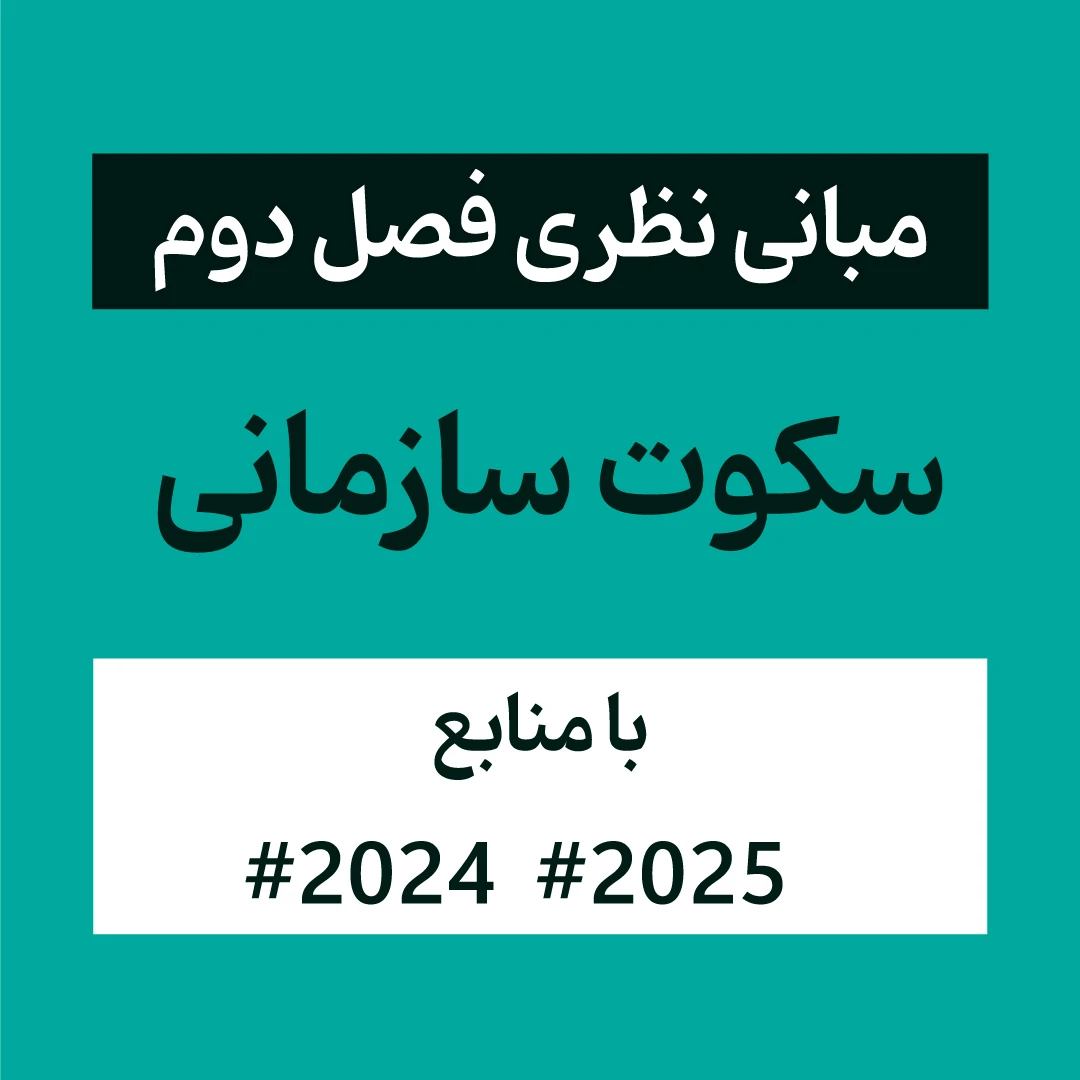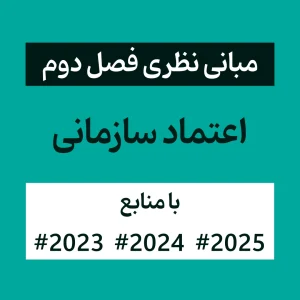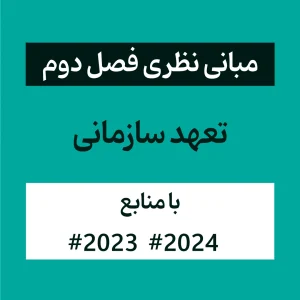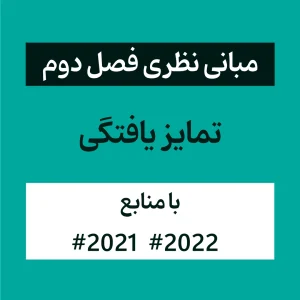نقد و بررسی
مبانی نظری و پیشینه پژوهش سکوت سازمانی با منابع 2024-2025فهرست مطالب:
- سکوت سازمانی
- تبارشناسی سکوت سازمانی
- مفهوم سکوت و نقش آن در سازمان
- سکوت مطیع (سکوت راضی با تسلیمی)
- سکوت تدافعی (خود حفاظتی)
- سکوت جامعه پسند (نوع دوستانه فرا اجتماعی یا ارتباط ورزانه)
- سکوت فرصت طلبانه
- عوامل مؤثر بر سکوت سازمانی
- پیامدهای سکوت سازمانی
- منابع فارسی
- منابع غیر فارسی
بخشی از محصول
سکوت سازمانی به عنوان یک مفهوم مهم . عمدتاً در ادبیات مدیریت به تازگی مورد بحث واقع شده است. این مفهوم امروزه در سازمانها بسیار قابل توجه است؛ زیرا در کوتاه مدت سکوت سازمانی یک سازه ای زیربنایی در حوادث سازمانی است و به معیار پنهان بسیاری از رفتارهای سازمانی تبدیل شده است؛ بنابراین، مقدار زیادی توجه پژوهشگران را در حوزه مدیریت به این پدیده مضر جلب کرده است در هر محیط کار، کارکنان دارای ایده ها و نظرات متفاوتی در مورد شرایط کار مسائل و مشکلات جاری، روش های بهبود شرایط و رفع مشکلات .هستند اینکه کارکنان تا چه حد مایل به بیان ایده ها و پیشنهادهای خود هستند و سازمان تا چه حد پذیرای نظرات آن هاست موضوع سکوت سازمانی را شکل می دهد(اولسر و همکاران، 2024).
Non-Persian References
- Baker A. J. L., Murray C., Adkins K. (2020). Parameters of reunification therapy and predictors of treatment success in high conflict divorce cases: A survey of mental health professionals. Journal of Divorce and Remarriage, 61(8), 593–614. https://doi.org/10.1080/10502556.2020.1824206.
- Cabanatuan, D., and Ahmad, C. (2022). Permissive parenting style and maladaptive behavioral tendencies among junior high school students of Notre dame of Tacurong College, Mindanao, Philippines. ASEAN Journal of Science and Engineering Education, 2(1), 87-96.
- Chang,H(2025). Lessons learned from victimised adults in Taiwan: what does it mean to repair parent–child relationships? Wiley Online Library,(46)1, https://doi.org/10.1002/anzf.1604.
- Kulkarni, S. (2017). Cross-cultural differences in child-rearing beliefs and practices: Implications for immigrant and nonimmigrant families. Journal of Child and Family Studies, 26(5), 1379-1393.
- Chen G., Nicotra E., Haviv N., Toys S. (2021). Parent-to-child violence: Does gender matter in sentencing decisions? Crime & Delinquency, 68(9), 1604–1626. https://doi.org/10.1177/00111287211057863
- Cotter A., Proctor K. B., Brestan-Knight E. (2018). Assessing child physical abuse: An examination of the factor structure and validity of the Parent-Child Conflict Tactics Scale (CTSPC). Children and Youth Services Review, 88, 467–475. https://doi.org/10.1016/j.childyouth.2018.03.044
- Hidayat, J. K. Azhar, and S. A. D. Hikmah, “Social Worker Intervention with Parents in Preventing Violent Behavior Towards Children,” Jurnal Penelitian dan Pengabdian Kepada Masyarakat (JPPM), vol. 3, no. 2, 2022. DOI: https://doi.org/10.24198/jppm.v3i2.40211
- Halim, A. I. Aritonang, and M. Wahjudianata, “Representation of Parental Roles in the Web Series ‘Little Mom’,” Jurnal e-Komunikasi, vol. 10, no. 2, 2022.
- Kobulsky J. M., Wildfeuer R., Yoon S., Cage J. (2021). Distinguishing characteristics and disparities in child protective services-investigated maltreatment by fathers. Child Maltreatment, 26(2), 182–194. https://doi.org/10.1177/1077559520950828
- Leone C., Hawkins L. B., Bright M. (2018). Minimizing mistreatment by female adults: The influence of gender-based social categories and personality differences on attitudes about child sexual abuse. The Journal of Psychology: Interdisciplinary and Applied, 153(4), 361–382. https://doi.org/10.1080/00223980.2018.1541439
- Lev.S, Schindler.M, Waksman.Y(2024). Social Workers’ Perceptions of the Effect of Interpersonal Factors on Older Adults’ Decision to Remain in Abusive Relationships, The British Journal of Social Work, (54) 2.
- Lui Z. J., Tan J. C. G., Koh C. W., Liu D., Elliott J. M., Fu C. S. L., Teo C. E. S. (2022). Perceptions of child maltreatment among professionals and the public in Singapore. Journal of Interpersonal Violence, 37(3–4), 1540–1565. https://doi.org/10.1177/0886260520921872
- Luo Y, Li HCW, Xia W, Cheung AT, Ho LLK, Chung JOK. The lived experience of resilience in parents of children with cancer: a phenomenological study. Front Pediatr. 2022;10:871435. doi:10.3389/fped.2022.871435
- Maher R. (2021). “The most disquieting of crimes”- an analysis of the killings of infants and the respective treatment of female and male offenders of this crime. The Dublin University Journal of Criminology, 1, 33–52. https://dujournalofcrimino.wixsite.com/dujc/past-volumes
- Nyoman, Ni, Ari Indra, and Fransiska Rismawati Hugo. “Gambaran Toxic Parents Yang Diterima Individu Dewasa Awal” 4 (2021).
- Park J. (2020). Offender characteristics and behaviors in NonSexual child maltreatment. Journal of Forensic Sciences, 65(3), 860–864. https://doi.org/10.1111/1556-4029.14270
- Palma, M. C., Escucha, T. N. V., Distor, Z. B., Tuyao, B. V., Malaco, A., and Estrellan, J. (2021). Parental academic support in online and modular learners amidst pandemic: A comparative study. Indonesian Journal of Community and Special Needs Education, 1(1), 31-36.
- Rodriguez C. M., Pu D. F. (2022). Parents who physically abuse: Current status and future directions. In Geffner R., White J. W., Hamberger L. K., Rosenbaum A., Vaughan-Eden V., Vieth V. I. (Eds.), Handbook of interpersonal violence and abuse across the lifespan (pp. 321–342): Springer. https://doi.org/10.1007/978-3-319-89999-2_183.
- Smith S, Tallon M, Clark C, Jones L, Mörelius E(2022). “You never exhale fully because you’re not sure what’s next”: parents’ experiences of stress caring for children with chronic conditions. Front Pediatr10:902655.
- Rianti, and Ahmad Dahlan(2022). “Karakteristik Toxic Parenting Anak Dalam Keluarga.” DIAJAR: Jurnal Pendidikan dan Pembelajaran 1, no. 2








0دیدگاه